Government Monarchy 10 CE Hajatria Historical era Ancient history | Established 200 BCE | |
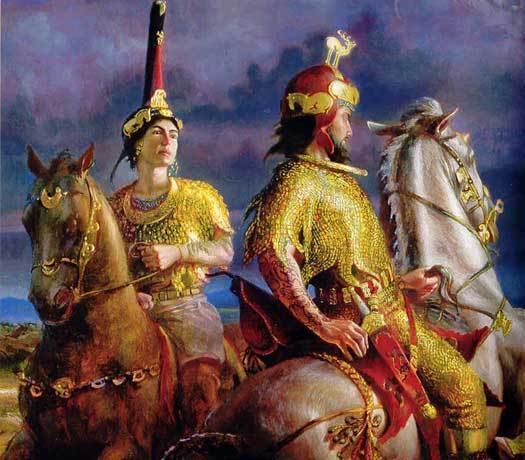 | ||
Languages Religion BuddhismHinduismAncient Greek religionZoroastrianism | ||
Indo-Scythians is a term used to refer to Scythians (Sakas), who migrated into parts of central, northern and western South Asia (Sogdiana, Bactria, Arachosia, Gandhara, Sindh, Kashmir, Punjab, Haryana, Rajasthan, Gujarat and Maharashtra) from the middle of the 2nd century BC to the 4th century AD.
Contents
- Indo scythians
- Origins
- Yuezhi expansion
- Settlement in Sakastan
- Abhira to Surastrene
- Gandhara and Punjab
- Sculpture
- Bimaran casket
- Mathura area Northern Satraps
- Pataliputra
- Kushan and Indo Parthian conquests
- Western Kshatrapas legacy
- Indo Scythian coinage
- Depiction of Indo Scythians
- Buner reliefs
- Stone palettes
- The Indo Scythians and Buddhism
- Royal dedications
- Butkara Stupa
- Gandharan sculptures
- Mathura lion capital
- Indo Scythians in Indian literature
- Sai Wang Scythian hordes of Chipin or Kipin
- Establishment of Mlechcha Kingdoms in Northern India
- Evidence about joint invasions
- Khyber Pakhtunkhwa and Eastern Pakistan
- Kshaharatas Punjab Pakistan and beyond
- Aprcas Bajaur Khyber Pakhtunkhwa Pakistan
- Pratas Balochistan Pakistan
- Northern Satraps Mathura area
- Minor local rulers
- Western Satraps
- Descendants of the Indo Scythians
- References
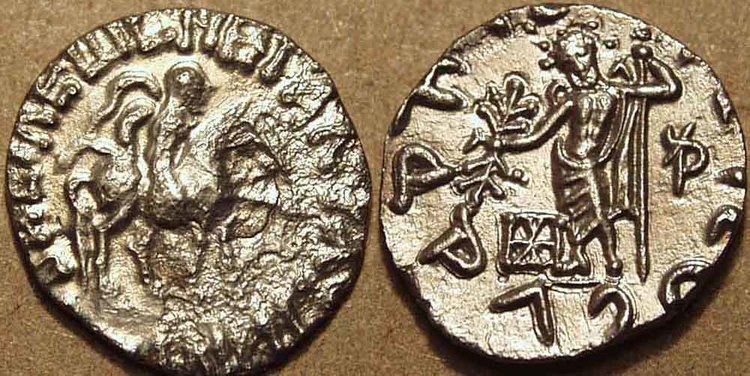
The first Saka king in south Asia was Maues (Moga) (1st century BC) who established Saka power in Gandhara (modern day Pakistan and Afghanistan region) and gradually extended supremacy over north-western India. Indo-Scythian rule in northwestern India ended with the last Western Satrap Rudrasimha III in 395 CE who was defeated by the Indian Emperor Chandragupta II of the Gupta Empire. The power of the Saka rulers started to decline in the 2nd century CE after the Indo-Scythians were defeated by the south Indian Emperor Gautamiputra Satakarni of the Satavahana dynasty. Later the Saka kingdom was completely destroyed by Chandragupta II of the Gupta Empire in the 4th century.

The invasion of India by Scythian tribes from Central Asia, often referred to as the Indo-Scythian invasion, played a significant part in the history of South Asia as well as nearby countries. In fact, the Indo-Scythian war is just one chapter in the events triggered by the nomadic flight of Central Asians from conflict with tribe such as the Xiongnu in the 2nd century AD, which had lasting effects on Bactria, Kabul, and India as well as far-off Rome in the west, and more nearby to the west in Parthia.
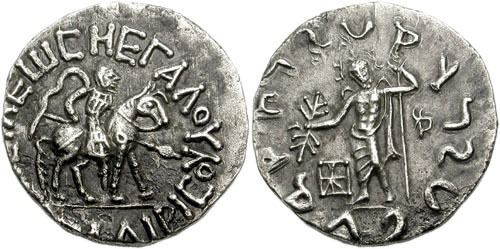
Ancient Roman historians including Arrian and Claudius Ptolemy have mentioned that the ancient Sakas ('Sakai') were basically nomads. However, Italo Ronca, in his detailed study of Ptolemy's chapter vi, marks the statement: "The land of the Sakai belongs to nomads, they have no towns but dwell in forests and caves" as spurious.

Indo scythians
Origins
The ancestors of the Indo-Scythians are thought to be Sakas (Scythian) tribes.
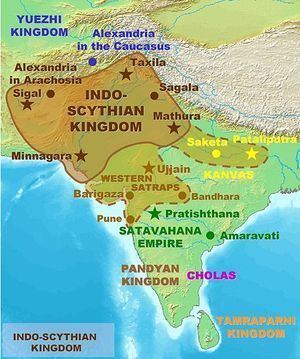
"One group of Indo-European speakers that makes an early appearance on the Xinjiang stage is the Saka (Ch. Sai). Saka is more a generic term than a name for a specific state or ethnic group; Saka tribes were part of a cultural continuum of early nomads across Siberia and the Central Eurasian steppe lands from Xinjiang to the Black Sea. Like the Scythians whom Herodotus describes in book four of his History (Saka is an Iranian word equivalent to the Greek Scythes, and many scholars refer to them together as Saka-Scythian), Sakas were Iranian-speaking horse nomads who deployed chariots in battle, sacrificed horses, and buried their dead in barrows or mound tombs called kurgans."
Yuezhi expansion
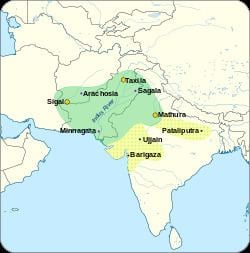
In the 2nd century BC, a fresh nomadic movement started among the Central Asian tribes, producing lasting effects on the history of Rome in Europe, Parthia in Western Asia, and Bactria, Kabul, and India in the east in Southern Asia. Recorded in the annals of the Han dynasty and other Chinese records, this great tribal movement began after the Yuezhi tribe was defeated by the Xiongnu, fleeing westwards after their defeat and creating a domino effect as they displaced other central Asian tribes in their path.
According to these ancient sources Modu Shanyu of the Xiongnu tribe of Mongolia attacked the Yuezhi and evicted them from their homeland between the Qilian Shan and Dunhuang. Leaving behind a remnant of their number, most of the population moved westwards.
Around 175 BC, the Yuezhi tribes (possibly related to the Tocharians who lived in eastern Tarim Basin area), were defeated by the Xiongnu tribes, and fled west into the Ili River area. There, they displaced the Sakas, who migrated south into Ferghana and Sogdiana. According to the Chinese historical chronicles (who call the Sakas, "Sai" 塞):
"The Yuezhi attacked the king of the Sai who moved a considerable distance to the south and the Yuezhi then occupied his lands" (Han Shu 61 4B).
Sometime after 155 BC, the Yuezhi were again defeated by an alliance of the Wusun and the Xiongnu, and were forced to move south, again displacing the Scythians, who migrated south towards Bactria and present Afghanistan, and south-west closer towards Parthia.
The Sakas seem to have entered the territory of the Greco-Bactrian Kingdom around 145 BC, where they burnt to the ground the Greek city of Alexandria on the Oxus. The Yuezhi remained in Sogdiana on the northern bank of the Oxus, but they became suzerains of the Sakas in Bactrian territory, as described by the Chinese ambassador Zhang Qian who visited the region around 126 BC.
In Parthia, between 138–124 BC, the Sakas tribes of the Massagetae and Sacaraucae came into conflict with the Parthian Empire, winning several battles, and killing successively King Phraates II and King Artabanus I.
The Parthian king Mithridates II finally retook control of parts of Central Asia, first by defeating the Yuezhi in Sogdiana in 115 BC, and then defeating the Scythians in Parthia and Seistan around 100 BC.
After their defeat, the Yuezhi tribes migrated relatively far to the east into Bactria, which they were to control for several centuries, and from which they later conquered northern India to found the Kushan Empire.
Settlement in Sakastan
The Sakas called home, an area of Southern Afghanistan, called after them Sistan. From there, they progressively expanded into present day Iran as well as northern India, where they established various kingdoms, and where they are known as "Saka".
The Arsacid emperor Mithridates II (c. 123–88/87 BCE) had scored many successes against the Scythians and added many provinces to the Parthian Empire, and apparently the Scythian hordes that came from Bactria were also conquered by him. A section of these people moved from Bactria to Lake Helmond in the wake of Yue-chi pressure and settled about Drangiana (Sigal), a region which later came to be called "Sakistana of the Skythian (Scythian) Sakai", towards the end of 1st century BC. The region is still known as Seistan.
The presence of the Sakas in Sakastan in the 1st century BC is mentioned by Isidore of Charax in his "Parthian stations". He explained that they were bordered at that time by Greek cities to the east (Alexandria of the Caucasus and Alexandria of the Arachosians), and the Parthian-controlled territory of Arachosia to the south:
"Beyond is Sacastana of the Scythian Sacae, which is also Paraetacena, 63 schoeni. There are the city of Barda and the city of Min and the city of Palacenti and the city of Sigal; in that place is the royal residence of the Sacae; and nearby is the city of Alexandria (Alexandria Arachosia), and six villages." Parthian stations, 18.Abhira to Surastrene
The first Indo-Scythian kingdom in south western Asia was located in Pakistan in the areas from Abiria (Sindh) to Surastrene (Saurashtra, Gujarat), from around 110 to 80 BC. They progressively further moved north into Indo-Greek territory until the conquests of Maues, c. 80 BC.
The 1st century AD Periplus of the Erythraean Sea describes the Scythian territories there:
"Beyond this region (Gedrosia), the continent making a wide curve from the east across the depths of the bays, there follows the coast district of Scythia, which lies above toward the north; the whole marshy; from which flows down the river Sinthus, the greatest of all the rivers that flow into the Erythraean Sea, bringing down an enormous volume of water (...) This river has seven mouths, very shallow and marshy, so that they are not navigable, except the one in the middle; at which by the shore, is the market-town, Barbaricum. Before it there lies a small island, and inland behind it is the metropolis of Scythia, Minnagara."The Indo-Scythians ultimately established a kingdom in the northwest, based in Taxila, with two great Satraps, one in Mathura in the east, and one in Surastrene (Gujarat) in the southwest.
In the southeast, the Indo-Scythians invaded the area of Ujjain, but were subsequently repelled in 57 BC by the Malwa king Vikramaditya. To commemorate the event Vikramaditya established the Vikrama era, a specific Indian calendar starting in 57 BC. More than a century later, in AD 78 the Sakas would again invade Ujjain and establish the Saka era, marking the beginning of the long-lived Saka Western Satraps kingdom.
Gandhara and Punjab
The presence of the Scythians in north-western India during the 1st century BCE was contemporary with that of the Indo-Greek Kingdoms there, and it seems they initially recognized the power of the local Greek rulers.
Maues first conquered Gandhara and Taxila around 80 BCE, but his kingdom disintegrated after his death. In the east, the Indian king Vikrama retook Ujjain from the Indo-Scythians, celebrating his victory by the creation of the Vikrama Era (starting 58 BCE). Indo-Greek kings again ruled after Maues, and prospered, as indicated by the profusion of coins from Kings Apollodotus II and Hippostratos. Not until Azes I, in 55 BC, did the Indo-Scythians take final control of northwestern India, with his victory over Hippostratos.
Sculpture
Several stone sculptures have been found in the Early Saka layer (Layer No4, corresponding to the period of Azes I, in which numerous coins of the latter were found) in the ruins of Sirkap, during the excavations organized by John Marshall.
Several of them are toilet trays (also called Stone palettes) roughly imitative of earlier, and finer, Hellenistic ones found in the earlier layers. Marshall comments that "we have a praiseworthy effort to copy a Hellenistic original but obviously without the appreciation of form and skill which were necessary for the task". From the same layer, several statuettes in the round are also known, in very rigid and frontal style.
Bimaran casket
Azes is connected to the Bimaran casket, one of the earliest representations of the Buddha. The casket was used for the dedication of a stupa in Bamiran, near Jalalabad in Afghanistan, and placed inside the stupa with several coins of Azes. This event may have happened during the reign of Azes (60–20 BCE), or slightly later. The Indo-Scythians are otherwise connected with Buddhism (see Mathura lion capital), and it is indeed possible they would have commended the work.
Mathura area ("Northern Satraps")
In central India, the Indo-Scythians conquered the area of Mathura over Indian kings around 60 BCE. Some of their satraps were Hagamasha and Hagana, who were in turn followed by the Saca Great Satrap Rajuvula.
The Mathura lion capital, an Indo-Scythian sandstone capital in crude style, from Mathura in Central India, and dated to the 1st century CE, describes in kharoshthi the gift of a stupa with a relic of the Buddha, by Queen Nadasi Kasa, the wife of the Indo-Scythian ruler of Mathura, Rajuvula. The capital also mentions the genealogy of several Indo-Scythian satraps of Mathura.
Rajuvula apparently eliminated the last of the Indo-Greek kings Strato II around 10 CE, and took his capital city, Sagala.
The coinage of the period, such as that of Rajuvula, tends to become very crude and barbarized in style. It is also very much debased, the silver content becoming lower and lower, in exchange for a higher proportion of bronze, an alloying technique (billon) suggesting less than wealthy finances.
The Mathura lion capital inscriptions attest that Mathura fell under the control of the Sakas. The inscriptions contain references to Kharahostes and Queen Ayasia, the "chief queen of the Indo-Scythian ruler of Mathura, satrap Rajuvula. Kharahostes was the son of Arta as is attested by his own coins. Arta is stated to be brother of King Moga or Maues.
The Indo-Scythian satraps of Mathura are sometimes called the "Northern Satraps", in opposition to the "Western Satraps" ruling in Gujarat and Malwa. After Rajuvula, several successors are known to have ruled as vassals to the Kushans, such as the "Great Satrap" Kharapallana and the "Satrap" Vanaspara, who are known from an inscription discovered in Sarnath, and dated to the 3rd year of Kanishka (c. AD 130), in which they were paying allegiance to the Kushans.
Pataliputra
The text of the Yuga Purana describes an invasion of Pataliputra by the Scythians sometimes during the 1st century BC, after seven great kings had ruled in succession in Saketa following the retreat of the Yavanas. The Yuga Purana explains that the king of the Sakas killed one fourth of the population, before he was himself slain by the Kalinga king Shata and a group of Sabalas (Sabaras or Bhillas).
Kushan and Indo-Parthian conquests
After the death of Azes, the rule of the Indo-Scythians in northwestern India was shattered with the rise of the Indo-Parthian ruler Gondophares in the last years of the 1st century BC. For the following decades, a number of minor Scythian leaders maintained themselves in local strongholds on the fringes of the loosely assembled Indo-Parthian empire, some of them paying formal allegiance to Gondophares I and his successors.
During the latter part of the 1st century AD, the Indo-Parthian overlordship was gradually replaced with that of the Kushans, one of the five tribes of the Yuezhi who had lived in Bactria for more than a century, and were now expanding into India to create a Kushan Empire. The Kushans ultimately regained northwestern India from around AD 75, and the area of Mathura from around AD 100, where they were to prosper for several centuries.
Western Kshatrapas legacy
Indo-Scythians continued to hold the area of Seistan until the reign of Bahram II (AD 276–293), and held several areas of India well into the 1st millennium: Kathiawar and Gujarat were under their rule until the 5th century under the designation of Western Kshatrapas, until they were eventually conquered by the Gupta emperor Chandragupta II (also called Vikramaditya).
Indo-Scythian coinage
Indo-Scythian coinage is generally of a high artistic quality, although it clearly deteriorates towards the disintegration of Indo-Scythian rule around AD 20 (coins of Rajuvula). A fairly high-quality but rather stereotypical coinage would continue in the Western Satraps until the 4th century.
Indo-Scythian coinage is generally quite realistic, artistically somewhere between Indo-Greek and Kushan coinage. It is often suggested Indo-Scythian coinage benefited from the help of Greek celators (Boppearachchi).
Indo-Scythian coins essentially continue the Indo-Greek tradition, by using the Greek language on the obverse and the Kharoshthi language on the reverse. The portrait of the king is never shown however, and is replaced by depictions of the king on horse (and sometimes on camel), or sometimes sitting cross-legged on a cushion. The reverse of their coins typically show Greek divinities.
Buddhist symbolism is present throughout Indo-Scythian coinage. In particular, they adopted the Indo-Greek practice since Menander I of showing divinities forming the vitarka mudra with their right hand (as for the mudra-forming Zeus on the coins of Maues or Azes II), or the presence of the Buddhist lion on the coins of the same two kings, or the triratana symbol on the coins of Zeionises.
Depiction of Indo-Scythians
Besides coinage, few works of art are known to indisputably represent Indo-Scythians. Indo-Scythians rulers are usually depicted on horseback in armour, but the coins of Azilises show the king in a simple, undecorated, tunic.
Several Gandharan sculptures also show foreigner in soft tunics, sometimes wearing the typical Scythian cap. They stand in contrast to representations of Kushan men, who seem to wear thicks, rigid, tunics, and who are generally represented in a much more simplistic manner.
Buner reliefs
Indo-Scythian soldiers in military attire are sometimes represented in Buddhist friezes in the art of Gandhara (particularly in Buner reliefs). They are depicted in ample tunics with trousers, and have heavy straight sword as a weapon. They wear a pointed hood (the Scythian cap or bashlyk), which distinguishes them from the Indo-Parthians who only wore a simple fillet over their bushy hair, and which is also systematically worn by Indo-Scythian rulers on their coins. With the right hand, some of them are forming the Karana mudra against evil spirits. In Gandhara, such friezes were used as decorations on the pedestals of Buddhist stupas. They are contemporary with other friezes representing people in purely Greek attire, hinting at an intermixing of Indo-Scythians (holding military power) and Indo-Greeks (confined, under Indo-Scythian rule, to civilian life).
Another relief is known where the same type of soldiers are playing musical instruments and dancing, activities which are widely represented elsewhere in Gandharan art: Indo-Scythians are typically shown as reveling devotees.
Stone palettes
Numerous stone palettes found in Gandhara are considered as good representatives of Indo-Scythian art. These palettes combine Greek and Iranian influences, and are often realized in a simple, archaic style. Stone palettes have only been found in archaeological layers corresponding to Indo-Greek, Indo-Scythian and Indo-Parthian rule, and are essentially unknown the preceding Mauryan layers or the succeeding Kushan layers.
Very often these palettes represent people in Greek dress in mythological scenes, a few in Parthian dress (head-bands over bushy hair, crossed-over jacket on a bare chest, jewelry, belt, baggy trousers), and even fewer in Indo-Scythian dress (Phrygian hat, tunic and comparatively straight trousers). A palette found in Sirkap and now in the New Delhi Museum shows a winged Indo-Scythian horseman riding winged deer, and being attacked by a lion.
The Indo-Scythians and Buddhism
The Indo-Scythians seem to have been followers of Buddhism, and many of their practices apparently continued those of the Indo-Greeks.
Royal dedications
Several Indo-Scythian kings after Azes are known for making Buddhist dedications in their name, on plaques or reliquaries:
Butkara Stupa
Excavation at the Butkara Stupa in Swat by an Italian archaeological team have yielded various Buddhist sculptures thought to belong to the Indo-Scythian period. In particular, an Indo-Corinthian capital representing a Buddhist devotee within foliage has been found which had a reliquary and coins of Azes buried at its base, securely dating the sculpture to around 20 BC. A contemporary pilaster with the image of a Buddhist devotee in Greek dress has also been found at the same spot, again suggesting a mingling of the two populations. Various reliefs at the same location show Indo-Scythians with their characteristic tunics and pointed hoods within a Buddhist context, and side-by-side with reliefs of standing Buddhas.
Gandharan sculptures
Other reliefs have been found, which show Indo-Scythian men with their characteristic pointed cap pushing a cart on which is reclining the Greek god Dionysos with his consort Ariadne.
Mathura lion capital
The Mathura lion capital, which associates many of the Indo-Scythian rulers from Maues to Rajuvula, mentions a dedication of a relic of the Buddha in a stupa. It also bears centrally the Buddhist symbol of the triratana, and is also filled with mentions of the bhagavat Buddha Sakyamuni, and characteristically Buddhist phrases such as:
"sarvabudhana puya dhamasa puya saghasa puya""Revere all the Buddhas, revere the dharma, revere the sangha"(Mathura lion capital, inscription O1/O2)Indo-Scythians in Indian literature
The Indo-Scythians were named "Shaka" in India, an extension on the name Saka used by the Persians to designate Scythians. From the time of the Mahabharata wars (400–150 BC roughly) Shakas receive numerous mentions in texts like the Puranas, the Manusmriti, the Ramayana, the Mahabharata, the Mahabhasiya of Patanjali, the Brhat Samhita of Vraha Mihira, the Kavyamimamsa, the Brihat-Katha-Manjari, the Katha-Saritsagara and several other old texts. They are described as part of an amalgam of other war-like tribes from the northwest.
Sai-Wang Scythian hordes of Chipin or Kipin
A section of the Central Asian Scythians (under Sai-Wang) is said to have taken southerly direction and after passing through the Pamirs it entered the Chipin or Kipin after crossing the Hasuna-tu (Hanging Pass) located above the valley of Kanda in Swat country. Chipin has been identified by Pelliot, Bagchi, Raychaudhury and some others with Kashmir while other scholars identify it with Kapisha (Kafirstan). The Sai-Wang had established his kingdom in Kipin. S. Konow interprets the Sai-Wang as Saka Murunda of Indian literature, Murunda being equal to Wang i.e. king, master or lord, but Bagchi who takes the word Wang in the sense of the king of the Scythians but he distinguishes the Sai Sakas from the Murunda Sakas. There are reasons to believe that Sai Scythians were Kamboja Scythians and therefore Sai-Wang belonged to the Scythianised Kambojas (i.e. Parama-Kambojas) of the Transoxiana region and came back to settle among his own stock after being evicted from his ancestral land located in Scythia or Shakadvipa. King Moga or Maues could have belonged to this group of Scythians who had migrated from the Sai country (Central Asia) to Chipin.
Establishment of Mlechcha Kingdoms in Northern India
The mixed Scythian hordes that migrated to Drangiana and surrounding regions, later spread further into north and south-west India via the lower Indus valley. Their migration spread into Sovira, Gujarat, Rajasthan and northern India, including kingdoms in the Indian mainland.
There are important references to the warring Mleccha hordes of the Sakas, Yavanas, Kambojas and Pahlavas in the Bala Kanda of the Valmiki Ramayana. H. C. Raychadhury glimpses in these verses the struggles between the Hindus and the invading hordes of Mlechcha barbarians from the northwest. The time frame for these struggles is the 2nd century BC onwards. Raychadhury fixes the date of the present version of the Valmiki Ramayana around or after the 2nd century AD.
Mahabharata too furnishes a veiled hint about the invasion of the mixed hordes from the northwest. Vanaparava by Mahabharata contains verses in the form of prophecy deploring that "......the Mlechha (barbaric) kings of the Shakas, Yavanas, Kambojas, Bahlikas, etc. shall rule the earth (i.e. India) un-righteously in Kaliyuga..".
According to H. C. Ray Chaudhury, this is too clear a statement to be ignored or explained away.
Evidence about joint invasions
The Scythian groups that invaded India and set up various kingdoms, included besides the Sakas other allied tribes, such as the Medii, Xanthii, Massagetae. These peoples were all absorbed into the community of Kshatriyas of mainstream Indian society.
The Shakas were formerly a people of trans-Hemodos region—the Shakadvipa of the Puranas or the Scythia of the classical writings. Isidor of Charax (beginning of 1st century AD) attests them in Sakastana (modern Seistan). 1st century AD Periplus of the Erythraean Sea (c. AD 70–80) also attests a Scythian district in lower Indus with Minnagra as its capital. Ptolemy (c. AD 140) also attests Indo-Scythia in south-western India which comprised Patalene the Surastrene (Saurashtra) territories.
The 2nd century BC Scythian invasion of India, was in all probability carried out jointly by the Sakas, Pahlavas, Kambojas, Paradas, Rishikas and other allied tribes from the northwest.
Khyber-Pakhtunkhwa and Eastern Pakistan
Kshaharatas (Punjab, Pakistan and beyond)
Aprācas (Bajaur, Khyber-Pakhtunkhwa, Pakistan)
Pāratas (Balochistan, Pakistan)
"Northern Satraps" (Mathura area)
Minor local rulers
Western Satraps
Descendants of the Indo-Scythians
Tadeusz Sulimirski notes that the Sacae also invaded parts of Northern India. Weer Rajendra Rishi, an Indian linguist has identified linguistic affinities between Indian and Central Asian languages, which further lends credence to the possibility of historical Sacae influence in Northern India.
